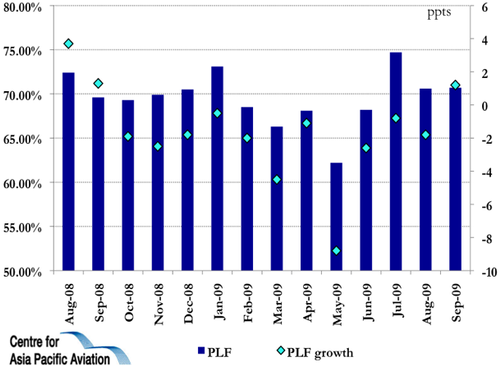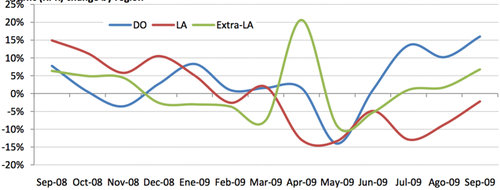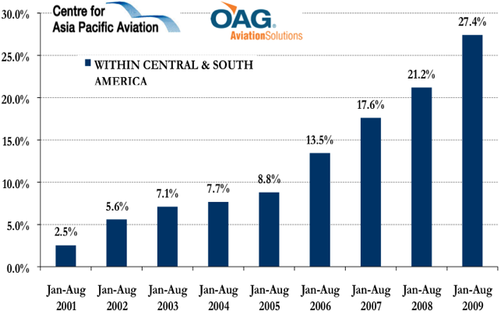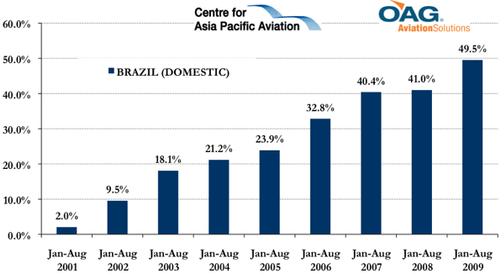Latin America/ Caribbean market “showing signs of recovery”
The Latin American and Caribbean Air Transport Association (which comprises 38 member airlines operating more than 800 aircraft in Argentina, Bolivia, Brazil, Cayman Islands, Chile, Colombia, Costa Rica, Cuba, Curacao, Ecuador, El Salvador, Guatemala, Honduras, Jamaica, Mexico, Netherlands Antilles, Nicaragua, Panama, Paraguay, Peru, Venezuela and Uruguay) stated Sep-2009 traffic revealed that the Latin American and Caribbean market is "showing signs of recovery".
Third consecutive month of pax growth in Sep-2009, but yield weakness remains
For the third consecutive month, passengers carried by member airlines increased on a year-on-year basis, up 10.8% to 10.3 million passengers. The industry also showed year-to-date increases in traffic (RPKs), capacity (ASKs) and load factors, up by 8.4%, 6.5% and 1.2 ppts, respectively.
ALTA passenger number growth, RPK growth and ASK growth: Aug-2008 to Sep-2009
ALTA passenger load factor and passenger number growth: Aug-2008 to Sep-2009
However, ALTA stated that yields are still down by approximately 10-20% for the region, depending on the carrier.
Latin American and Caribbean Air Transport Association (ALTA) traffic: Oct-2009
|
|
Oct-2009 |
Year-on-year change |
|---|---|---|
|
Passenger numbers (mill) |
10.3 |
+10.9% |
|
Domestic (mill) |
7.2 |
+15.9% |
|
31,661 |
-2.7% |
|
|
Trans-Atlantic |
269,107 |
+19.4% |
|
Latin America (mill) |
2.0 |
+0.7% |
|
801,539 |
+0.7% |
|
|
Load factor (%) |
70.7% |
+1.2 ppts |
|
Domestic |
66.6% |
+2.8 ppts |
|
74.4% |
-4.4 ppts |
|
|
Trans-Atlantic |
81.4% |
-2.1 ppts |
|
71.9% |
+0.8 ppts |
|
|
71.4% |
+1.1 ppts |
Domestic passenger numbers in the countries that make up the grouping have also now been growing for three consecutive months, with Sep-2009's growth the first month of double-digit growth since Aug-2009. This compares to a trough of -12.3% in May-2009.
Domestic markets strong within the region
Domestic traffic in terms of RPKs remained the strongest area of traffic growth in Sep-2009, up 16.0% year-on-year, on a capacity (ASKs) growth of 11.2%, reflecting the strength and size of the domestic markets within the region (domestic traffic represented 43% of the total traffic to, from and within the region during the month and 69% of total passenger numbers).
Meanwhile, extra-Latin America traffic and passenger growth of 6.8% and 1.6% was seen in the month, as carriers in the region continue to restructure their international operations.
ALTA traffic (RPKs) by region: Sep-2008 to Sep-2009
LCCs have a quarter of capacity within Central and Southern America
LCCs within the region currently have a 27.4% capacity (seats) share of the intra-regional market, a significant improvement from just 2.5% in 2001.
Central and South America intra regional capacity (seats per month), LCCs as a percentage of the total: Jan-Aug-2001 to Jan-Aug-2009
Brazil one of the fastest growing Latin American/Caribbean regions
Within this region, Brazil is one of the fastest growing markets, with ten Brazilian airports featuring in the 20 fastest growing airports according to ALTA, in its 'Latin American and Caribbean Capacity Analysis 2009', which covers 2008 data.
Fastest growing airports in Latin America (by flight added, domestic and international): 2008
Brazil also has five of the twenty largest airports in the Latin America/Caribbean region, led by airports in Sao Paulo, Rio de Janeiro and Brasilia. Rio de Janeiro-Sao Paulo, meanwhile, remains the busiest city pair in the whole region, with more than double the capacity of the second city pair, Mexico City-Monterrey, which is the fastest growing domestic city pair in Latin America. There are, on average, 86 daily services between Rio de Janeiro and Sao Paulo, with over 4.2 million seats.
Largest airports in Latin American and the Carribbean (all services): 2008
Propensity for travel remains low in Brazil
However, Brazil's propensity for travel still remains low compared to its neighbouring countries: Brazil's population of 190 million took roughly 100 million flights in 2008 - a proportion that lags several other Latin American countries, including Panama, Costa Rica, Jamaica, Colombia, Mexico, Chile, Venezuela and others.
Selected Latin American countries' GDP per capita^ and propensity to travel* by air
Brazil's LCCs and start-ups gaining market share
However, this propensity is expected to grow, with Brazil's start-up carriers, led by Azul Linhas, Webjet and Trip, expanding their presence in the domestic market over the past 12 months.
Brazil's smaller carriers predominantly serve the country's large, yet under-penetrated, secondary and leisure markets, which present significant opportunities for future expansion.
Azul captures 4.4% market share, exceeding 2009 targets
David Neeleman (JetBlue Founder)-led Azul, Brazil's most recent start-up, has already captured 4.4% of the domestic market in Oct-2009, to become the third largest airline in the country, according to Brazil's National Civil Aviation Agency (ANAC).
Azul, at the commencement of operations, stated it planned to gain a 3% domestic market share in Brazil by the end of 2009 by offering fares 15-20% lower than its two main competitors, full service TAM and LCC GOL. The carrier reached this target just half way into the year, with no slowdown in sight.
GOL and TAM remain dominant
However, GOL and TAM still remain the dominant players in Brazil.
GOL had a 42% capacity (seats) share of the domestic market, with TAM holding a 45% share in Oct-2009, with LCCs now dominating the domestic market with 50% capacity share, a significant improvement from just 2% in 2001.
Brazil domestic capacity (seats per month), LCCs as a percentage of the total: Jan-Aug-2001 to Jan-Aug-2009
Strong Brazil domestic traffic figures in Oct-2009
Brazil's total domestic market traffic (RPKs) increased 42.0% year-on-year in Oct-2009, while international traffic rose 11.9%, despite significant international capacity rationalisation by GOL/VRG.
These positive domestic traffic developments in the past few months have continued to create speculation that Brazilian air travel demand will recover in 2H2009 and 2010.
This also coincides with an expected economic recovery in the Brazilian market, with President, Luiz Inacio Lula da Silva, on 17-Nov-2009 stating that Brazil's economy may have expanded approximately 9% in 3Q2009, adding that the economy is growing at a "Chinese pace".
Budget Minister, Paulo Bernardo, added that the government may revise its forecast for economic growth for 2010 from the current forecast of 4.5% to 5%.
Load factors on the improve
Brazilian carriers have also reported significantly improved load factors (+11.0 ppts on domestic operations) to slightly below 73%, as the traffic gains exceeded the 20.5% capacity (ASKs) increase in the month. Individual carriers' load factors ranged from 30.8% (SOL) to 94.4% (PUMA Air).
GOL increased domestic capacity by 15.5% in the month, as it directed most of its seats towards the domestic market, and away from its international operations (international capacity was down 22%), in line with its focus on increasing the profitability of its network.
ANAC domestic traffic highlights for Oct-2009
|
Carrier |
Pax traffic (RPKs) |
% Change |
Capacity (ASKs) |
% Change |
Load Factor (%) |
% Change |
|---|---|---|---|---|---|---|
|
Total (000s) |
5,369,200 |
+42.00 |
7,399,071 |
+20.52 |
72.57% |
+10.97 ppts |
|
2,393,515 |
+22.27 |
3,312,986 |
+9.57 |
72.25% |
+7.51 ppts |
|
|
GOL/VRG |
2,238,917 |
+46.90 |
3,077,265 |
+15.46 |
72.76% |
+15.57 ppts |
|
240,182 |
+94.42 |
356,088 |
+86.83 |
67.45% |
+2.63 ppts |
|
|
238,408 |
n/a |
273,518 |
n/a |
87.16% |
n/a |
|
|
122,613 |
+30.30 |
167,914 |
+32.03 |
73.02% |
-0.97 ppts |
|
|
TRIP |
92,739 |
+75.32 |
144,480 |
+65.25 |
64.19% |
+3.69 ppts |
|
22,475 |
+128.47 |
36,293 |
+140.78 |
61.92% |
-3.34 ppts |
|
|
7,949 |
+14.00 |
12,362 |
+4.33 |
64.31% |
+5.46 ppts |
|
|
TOTAL |
5,407 |
-5.89 |
6,179 |
-8.68 |
87.50% |
+2.60 ppts |
|
2,068 |
+8.59 |
3,512 |
+4.30 |
58.88% |
+2.33 ppts |
|
|
META |
1,548 |
-12.32 |
1,780 |
-15.97 |
86.96% |
+3.62 ppts |
|
1,425 |
-10.00 |
3,062 |
-12.50 |
46.52% |
+1.30 ppts |
|
|
SETE |
1,166 |
n/a |
1,719 |
n/a |
67.82% |
n/a |
|
Rico |
250 |
-66.15 |
390 |
-66.27 |
64.16% |
+0.23 ppts |
|
139 |
-60.92 |
447 |
-52.15 |
31.04% |
-6.97 ppts |
|
|
Abaete |
144 |
+13.06 |
248 |
+6.08 |
57.84% |
+3.57 ppts |
|
PUMA Air |
2.89 |
-90.03 |
3.06 |
-91.73 |
94.44% |
+16.07 ppts |
|
254 |
n/a |
824 |
n/a |
30.75% |
n/a |
GOL continues to scale back international expansion; adding codeshare partnerships to cover international operations
GOL, which posted its third consecutive quarter of profitability in 3Q2009, with a net profit of USD46 million, is continuing to restructure its route network, with the carrier consolidating its international network, including suspending services to European, North American and certain South America destinations, shifting focus toward its domestic network and the Caribbean. According to GOL CEO, Constantino de Oliveira, approximately 90% of the carrier's revenue is generated from domestic routes.
As GOL cuts back on international operations, the carrier is continuing to seek new partnerships to feed its domestic operations.
Yields on the improve
Another positive sign in the Brazilian market is that yields are showing signs of improvement, despite the highly competitive domestic market.
GOL, in its Oct-2009 traffic release, stated its average net yield was maintained at close to BRL17.00 cents, with sales for Nov-2009 and Dec-2009 "already showing clear signs of a recovery".
The LCC added that the "highly competitive price scenario" began to ease off in the first week of October, although this was the period in which the majority of tickets were sold in the month.
Looking forward, GOL added that yields are "expected to initiate a gradual recovery" in the final quarter of 2009, "especially in November and December, given that demand is continuing to grow in a second half where the outlook is distinctly more optimistic than in the first".
Similarly, TAM, in its traffic release for the month, stated that as of the last week of September, we initiated a readjustment movement of our yields and, as a result, we observed a growth between 5 and 10% in October in comparison to the previous month".
TAM added that its international market has presented a "more rational and stronger recovery", with the carrier estimating yield growth of 10-15% for Oct-2009, compared to Sep-2009 levels.
GOL aiming for profitability in 2009 by focusing on growing domestic market
GOL expects to be profitable this year as a result of its network reorganisation and the (finally) successful integration of VRG/GOL operations, as well as the introduction of ancillary charges.
However, possibly the most positive sign for GOL is the large increase in domestic market growth that the LCC is now anticipating. GOL, upon the release of its 3Q2009 financial results, stated domestic demand may grow by as much as 14% in 2009, a dramatic increase from the previous estimates of between 2% and 4%.
According to CFO, Leonardo Pereira, "demand has been stronger than we imagined. Things that were unthinkable a few months ago are happening now." Mr Pereira added, "there's an increase in demand generated by a reduction in ticket prices, but a larger part of the demand growth comes from the economic recovery".
This is particularly beneficial for GOL, which is now increasing its focus on the domestic market.
GOL 2009 and 2010 Consolidated Guidance
|
Currency: USD |
2009E (Dec-08) |
2009E (Mar-09) |
2009E (Jun-09) |
2009E (Sep-09) |
2010E (Mar-09) |
|---|---|---|---|---|---|
|
Passengers (mill) |
29 |
28 |
28 |
28 |
28 |
|
Domestic market growth (% RPKs) |
6.0 |
2.0-4.0 |
2.0-4.0 |
10-14% |
2.0-4.0 |
|
Capacity (ASKs) (bill) Domestic International |
40.5 34.0 6.5 |
40.5 34.5 6.0 |
40.0 35.0 5.0 |
40.0 35.0 5.0 |
40.5 35.0 5.5 |
|
Fleet (end of period) |
108 |
108 |
108 |
108 |
108 |
|
Traffic (RPKs) (bill) |
25.8 |
24.5 |
24.5 |
25.3 |
24.5 |
|
Departures (000) |
290 |
290 |
290 |
280 |
290 |
|
Cost per ASK (ex fuel) |
3.93 |
5.39 |
4.88 |
Lower then forecast |
4.79 |
|
Fuel cost per litre |
0.84 |
0.81 |
0.86 |
0.86 |
0.72 |
|
Fuel litres consumed (mill) |
1.25 |
1.30 |
1.30 |
1.30 |
1.30 |
|
Average exchange rate (BRL/USD) |
1.95 |
2.29 |
2.09 |
2.00 |
2.29 |
TAM also seeing improved domestic growth
TAM, which reported a net profit of USD201 million in the three months ended Sep-2009 (compared to a loss of USD383 million in the previous corresponding period), added that it has been "observing a strong demand recovery since the end of the third quarter of 2009".
Like GOL, TAM added that the domestic market presents even higher growth prospects than its revised estimates (TAM believed growth would be between 1-5%, which it has now upgraded to 7-10%).
TAM 2009 Guidance
|
Currency: USD |
2009 Guidance |
Realised Jan-Oct |
|---|---|---|
|
Domestic market demand growth (RPKs) |
7-10% |
13.5% |
|
Domestic market leadership |
- |
46.1% |
|
International market leadership |
- |
86.8% |
|
ASK growth - domestic market |
8% |
9.7% |
|
ASK growth - international market |
20% |
21.9% |
|
Average load factor |
67% |
67.9% |
Outlook: GOL and TAM to remain dominant in the major centres, but facing new pressure from Azul
GOL and TAM will remain the dominant carriers in Brazil, with their access to key business markets and travelers, through their control of the majority of landing slots at the country's major airports.
According to TAM, the 12 major airports in Brazil account for 90% of revenues in the domestic Brazilian market, with TAM and GOL controlling 92% of operations at these airports. This has prompted TAM to state, "we have a strong presence, which will be tough to budge".
However, Azul Founder, David Neeleman, remains optimistic that Azul will fill a need in the market, focusing on leisure travelers and secondary markets, and its rapid growth and rising market share support this.







